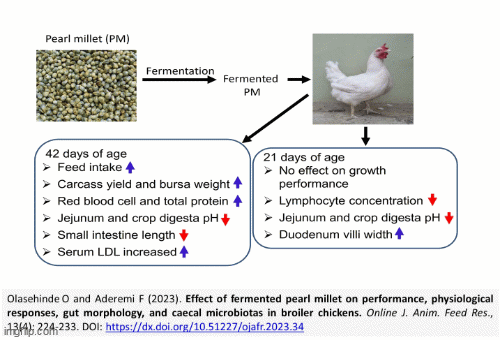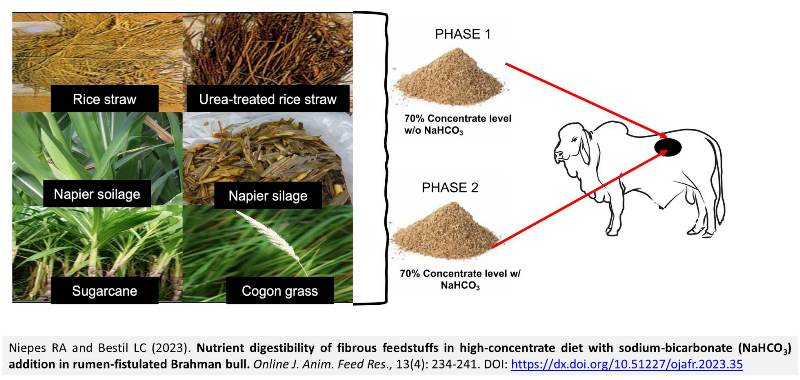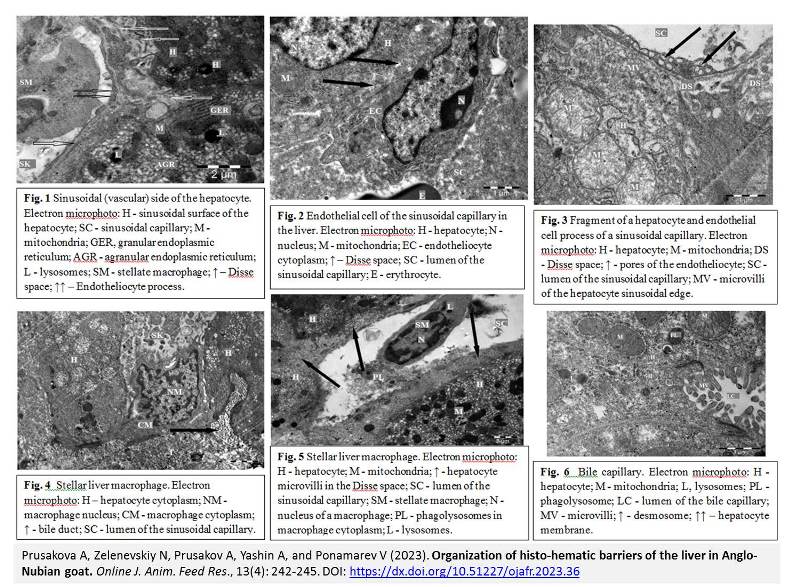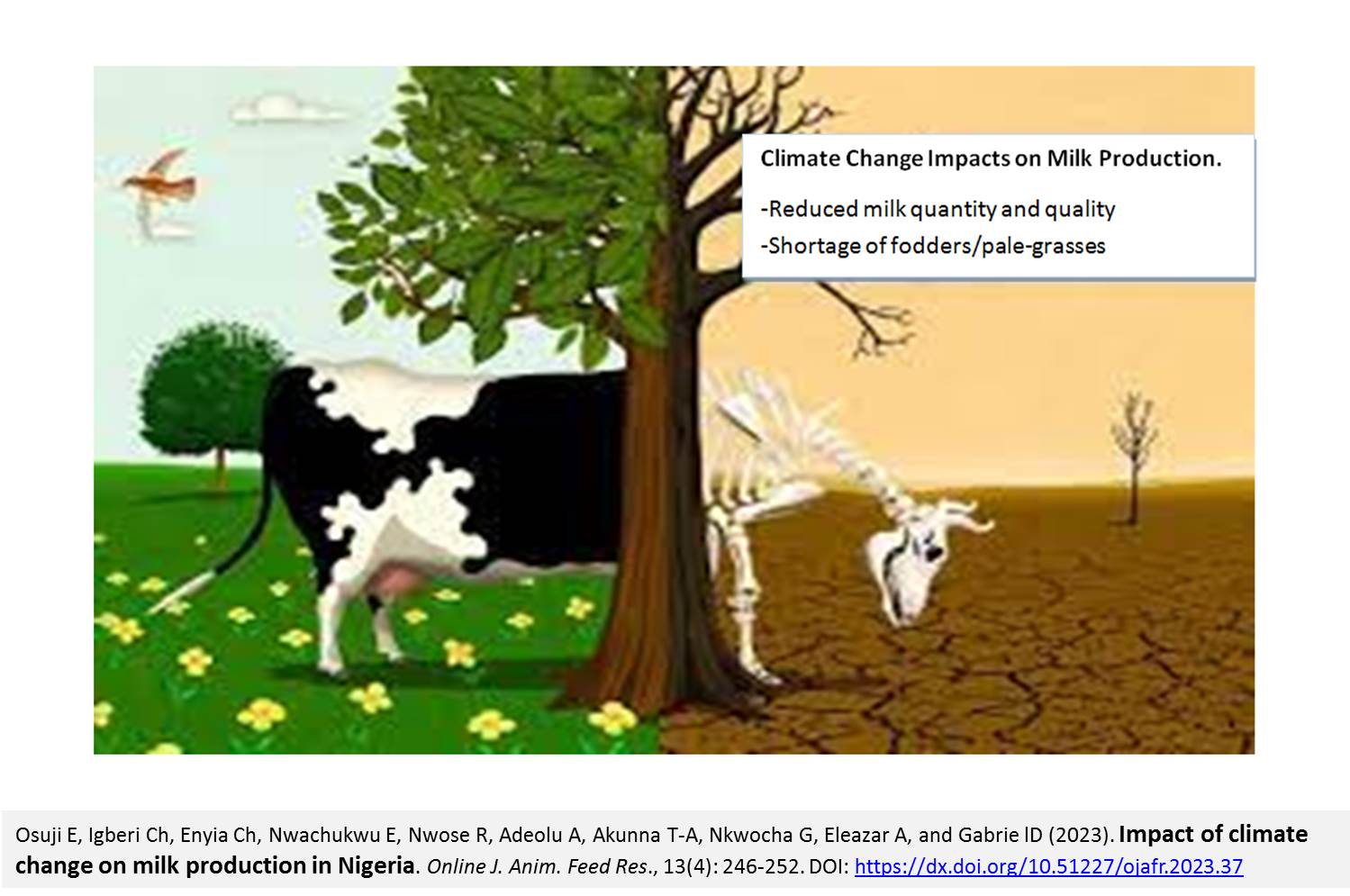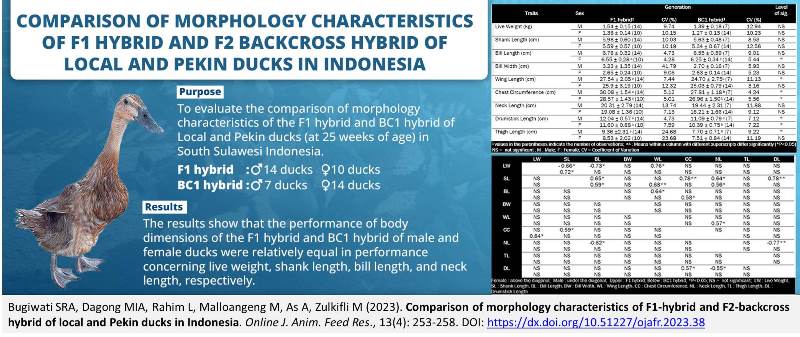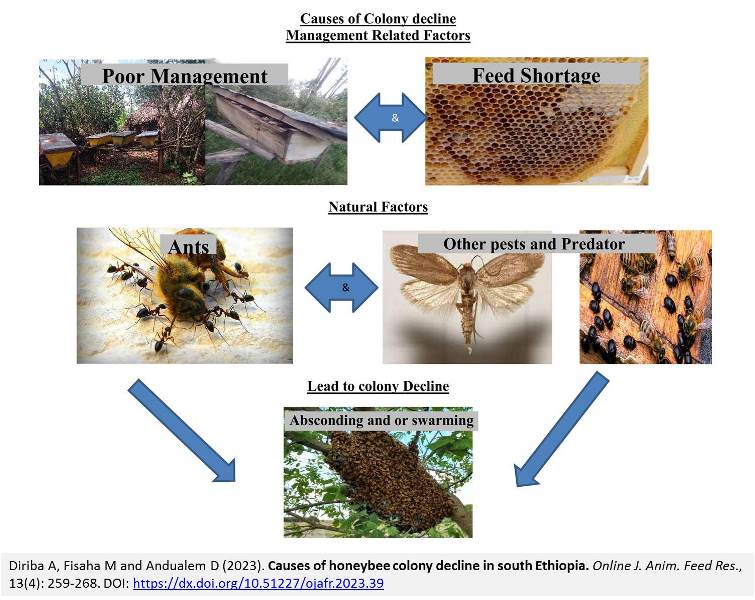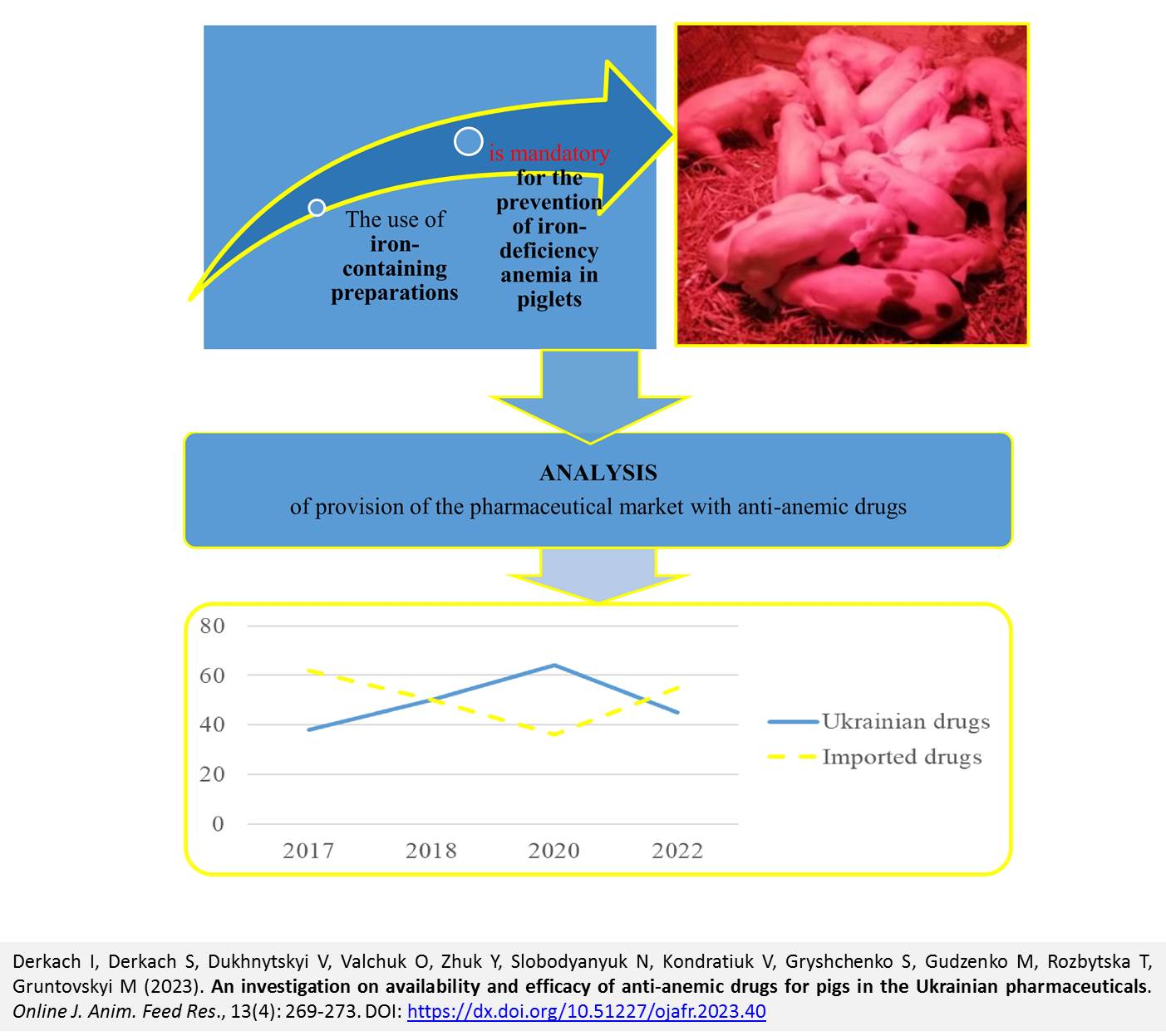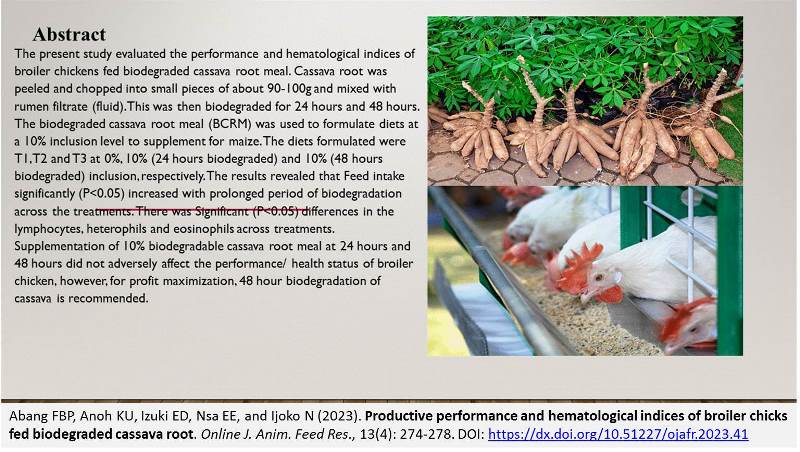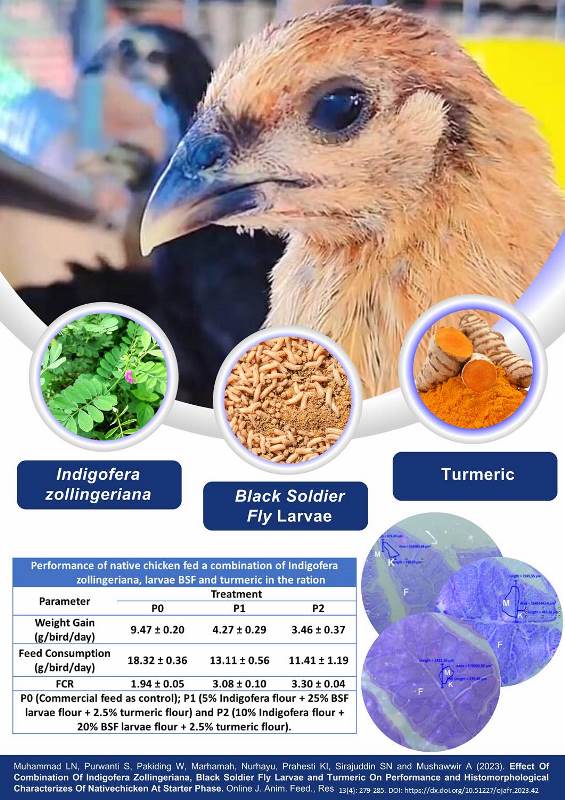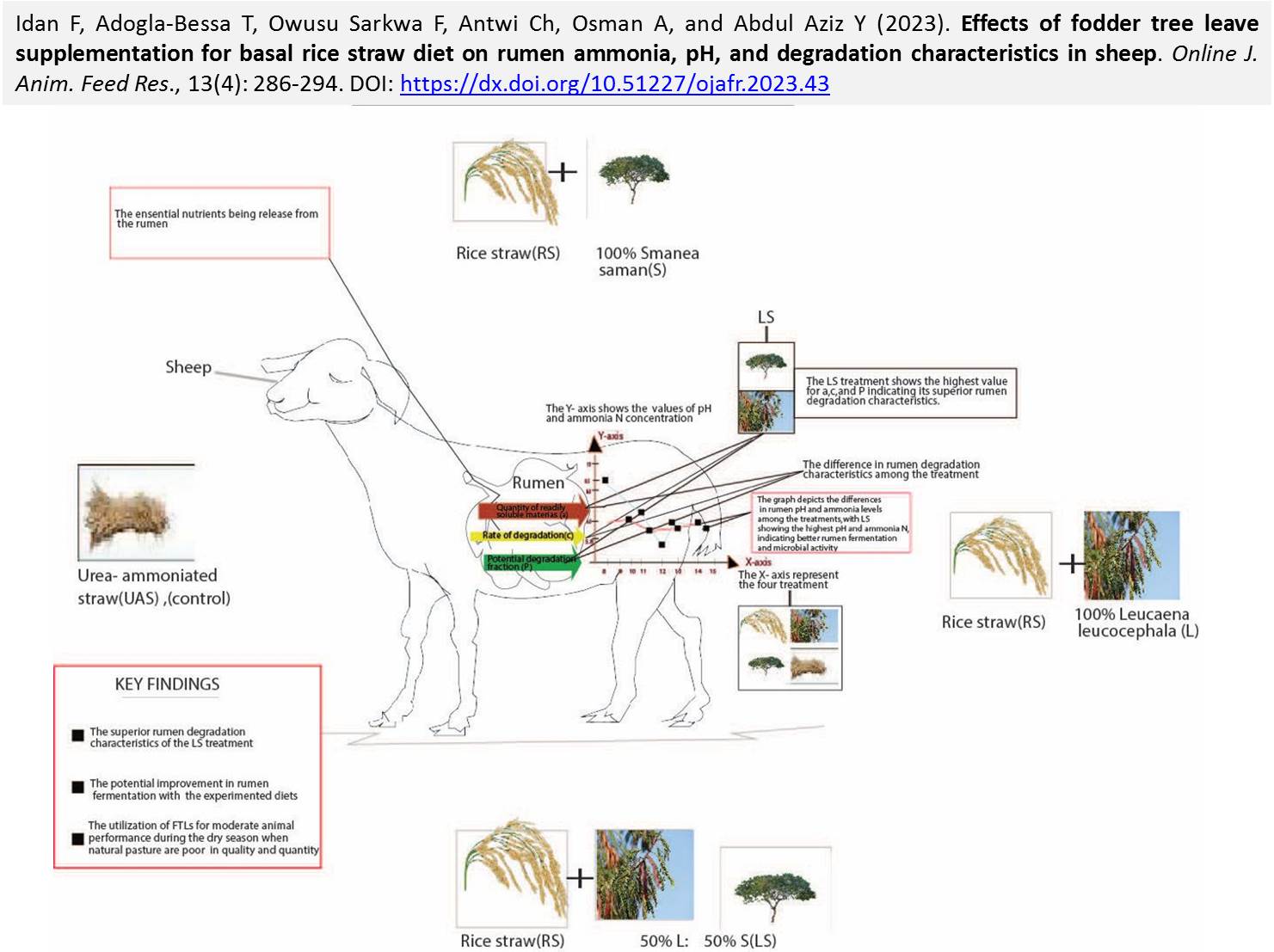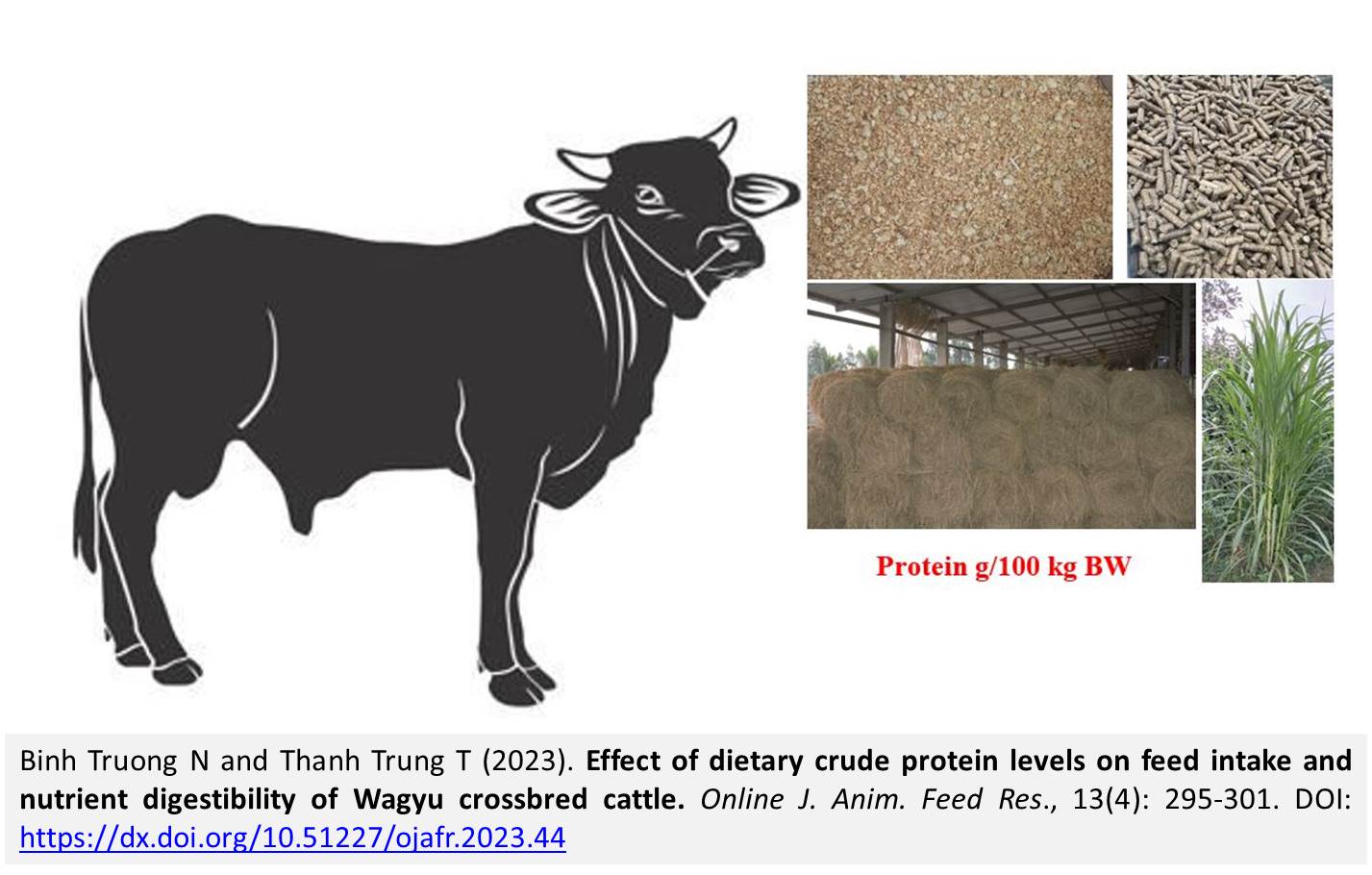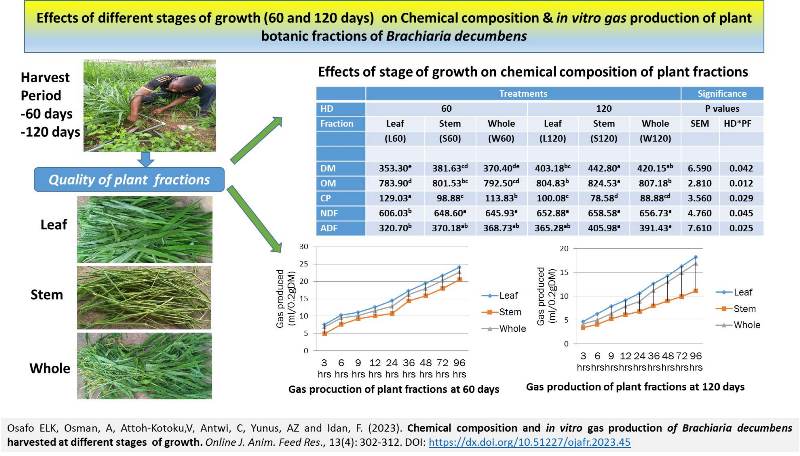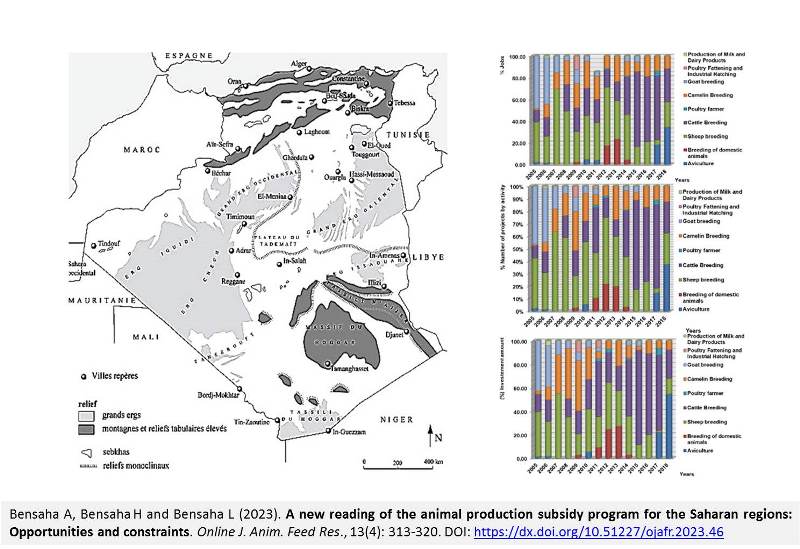Previous issue | Next issue | Archive
![]() Volume 13 (4); July 27, 2023 [Booklet]
Volume 13 (4); July 27, 2023 [Booklet]
Effect of fermented pearl millet on performance, physiological responses, gut morphology, and caecal microbiotas in broiler chickens
Olasehinde O and Aderemi F.
Online J. Anim. Feed Res., 13(4): 224-233, 2023; pii: S222877012300034-13
DOI: https://dx.doi.org/10.51227/ojafr.2023.34
Abstract: This study evaluated the contribution of fermented pearl millet [Pennisetum glaucum (L) R. Br.,] on growth performance, physiological responses, gut morphology, and microbial composition in the caeca. One hundred and eighty day-old Arbor Acre broiler chicks were assigned into five groups and were fed starter (d 0 to 21) and finisher (d 22 to 42) diets. Test diets included a control composed of maize-soybean meal (0%); a similar diet with maize replaced with fermented pearl millet (FPM) at 25, 50, 75, and 100%. Results showed that there was no significant improvement in weight gain and feed conversion ratio although more feed was consumed (P = 0.035) as FPM increased in the diet. Carcass yield increased linearly (P = 0.05) at d 42. Bursa of Fabricius quadratically increased (P = 0.02) in weight particularly at 25% and 50% FPM levels at d 21. Concentrations of total protein (P = 0.026) and low-density lipoprotein (P = 0.037) increased linearly as FPM increased in the diets. Proventriculus weight, lymphocyte concentration in the blood, and size of gut segments linearly reduced (P < 0.05). Proventriculus and crop pH improved linearly (P = 0.05) while digesta pH in jejunum reduced linearly (P = 0.005) at d 21. Duodenal villus width increased quadratically (P = 0.008), and the highest width occurred in the 50% FPM group. Furthermore, dietary FPM did not influence caeca Salmonella and Lactobacillus. In conclusion, replacement of maize with FPM had no adverse effect on performance, physiological status, gut morphology and microbial composition of broiler chickens. Our results suggest that FPM represents a potential alternative in diets of broiler chickens without sacrificing the nutritional quality of the diet.
Keywords: Broiler chickens, Fermented pearl millet, Gut morphology, Gut microbiota, Nutritional quality.
[Full text-PDF] [Scopus] [ePub] [Export from ePrints]
Nutrient digestibility of fibrous feedstuffs in high-concentrate diet with sodium-bicarbonate (NaHCO3) addition in rumen-fistulated Brahman bull
Niepes RA and Bestil LC.
Online J. Anim. Feed Res., 13(4): 234-241, 2023; pii: S222877012300035-13
DOI: https://dx.doi.org/10.51227/ojafr.2023.35
Abstract: Ruminants are given substantial quantities of concentrate diets full of quickly fermentable carbohydrates to increase output performance; however, it can also lead to digestive disorders. This study aimed to investigate the effect of adding NaCHO3 to a high-concentrate diet on the nutrient digestibility of locally available fibrous feedstuffs in the Philippines. The experiment utilized a rumen-fistulated Brahman bull. The treatment diets were the following: Treatment 1 (T1): Untreated rice (Oryza sativa L.) straw; T2: Urea-treated rice straw; T3: Napier grass (Pennisetum purpureum Schumach); T4: Napier silage; T5: Sugar cane (Saccharum officinarum L.) tops; and T6: Cogon grass (Imperata cylindrica L.). The nylon bags containing the treatment diets were incubated in the rumen at two periods: first at a high-concentrate (70% level), and second at a high concentrate added with NaCHO3). The results showed that the nutrient digestibility of locally-available feedstuffs varies significantly (p<0.05) both with and without NaHCO3. The addition of NaHCO3 in a high-fiber diet improves the digestibility of locally available fibrous feedstuffs in terms of dry matter (DM), organic matter (OM), and neutral detergent fiber (NDF). Therefore, the addition of NaHCO3 to a high-concentrate diet has the potential to positively stabilize rumen pH and enhance the nutrient digestibility of locally available fibrous feedstuffs.
Keywords: Fibrous feedstuffs, in situ digestibility, Nutrient digestibility, Rumen, Sodium bicarbonate.
[Full text-PDF] [Scopus] [ePub] [Export from ePrints]
Organization of histo-hematic barriers of the liver in Anglo-Nubian goat
Prusakova A, Zelenevskiy N, Prusakov A, Yashin A, and Ponamarev V.
Online J. Anim. Feed Res., 13(4): 242-245, 2023; pii: S222877012300036-13
DOI: https://dx.doi.org/10.51227/ojafr.2023.36
Abstract: The aim of this research was to establish features of the liver histo-hematic barriers ultrastructural organization of the Anglo-Nubian goat. The liver of an adult Anglo-Nubian goat was used as the material. The work was carried out using the electron microscopic method. Liver parenchymal tissue fragments were selected. These samples were fixed in a 2.0% glutaraldehyde solution on a cacodylate buffer for two hours. They were then washed in three portions of the same buffer and post-fixed in a 1.0% solution of osmium tetrachloride for one hour. The samples were then dehydrated in alcohols of ascending concentration and absolute acetone. The subsequent filling of the fragments was carried out in Epon-812. Ultrathin sections were obtained on an ultramicrotome, contrasted with a 2.0% aqueous solution of uranyl acetate and a solution of lead citrate. The ultrathin sections were photographed with a Jem-1011 electron microscope at magnifications of 2500-3000. Two histo-hematic barriers are detected in the liver of the studied animals hemato-hepatic and hepatobiliary. The hemato-hepatic barrier is formed by the plasmalemma of the apical end of the hepatocyte, covered by the glycocalyx, the perisinusoidal space of the Disse, the endotheliocyte of the sinusoid capillary, as well as Kupfer cells located in the lumen of the latter. The hepatobiliary includes all of the above structures, with the exception of Kupfer cells, as well as the plasmalemma of the basal end of the hepatocyte. All of the above structures in their organization have characteristic species features for Anglo-Nubian goats.
Keywords: Anglo-Nubian goat, Digestive organs, Hepatobiliary barrier, Hemato-hepatic barrier, Liver.
[Full text-PDF] [Scopus] [ePub] [Export from ePrints]
Impact of climate change on dairy milk production in Nigeria
Osuji E, Igberi Ch, Enyia Ch, Nwachukwu E, Nwose R, Adeolu A, Akunna T-A, Nkwocha G, Eleazar A, and Gabrie lD.
Online J. Anim. Feed Res., 13(4): 246-252, 2023; pii: S222877012300037-13
DOI: https://dx.doi.org/10.51227/ojafr.2023.37
Abstract: This study explores the impacts of climate change on milk production in Nigeria. Climate variables such as temperature, rainfall, sunshine, relative humidity and wind speed were considered as covariates in the analysis. Time-series data spanning a period of forty years obtained from the Central Bank of Nigeria and FAOSTAT database was used. The autoregressive distributed lag model was used to analyze both the short run and long run impacts of climate change on milk production. As expected, not all the variables were stationary at levels, but they were all significant at the difference suggesting the presence of cointegration. The result showed that the Bound’s test F-ratio was statistically significant implies the existence of long run and short run relationships among the variables studied. Present findings revealed that temperature, rainfall and relative humidity had a negative impact on milk production, while sunlight recorded a positive impact on milk production both in the short run and long run estimates. The study concludes that milk production in Nigeria dropped as a result of climate change particularly rising temperature and prolonged rainfall. Agricultural climate smart practices were recommended to mitigate impact of climate change on milk production.
Keywords: Climate Change, Dairy Products, Production, Rainfall, ARDL model.
[Full text-PDF] [Scopus] [ePub] [Export from ePrints]
Comparison of morphology characteristics of F1-hybrid and F2-backcross hybrid of local and Pekin ducks in Indonesia
Bugiwati SRA, Dagong MIA, Rahim L, Malloangeng M, As A, Zulkifli M.
Online J. Anim. Feed Res., 13(4): 253-258, 2023; pii: S222877012300038-13
DOI: https://dx.doi.org/10.51227/ojafr.2023.38
Abstract: The purpose of this study was to evaluate the comparison of morphology characteristics of two groups (the F1 and F2 backcross of Local and Pekin ducks at 25 weeks of age) in South Sulawesi Indonesia. The research material used 14 ducks males and 10 ducks females of F1 and 7 ducks males and 14 ducks females of F2-backcross. The data were measured on live weight, shank length, bill length, bill width, wing length, chest circumference, neck length, drumstick length, and thigh length. All mean differences of quantitative data from those two groups were analyzed using Independent T-test. The results showed that the performance of body dimensions of the F1 and F2-backcross of male and female ducks were relatively equal in performance concerning live weight, shank length, bill length, and neck length, respectively. The highest and positive correlation exists between shank length with chest circumference and drumstick (r=0.78) of F1 backcross female duck, between live weight with shank length (r=0.72) of F2-backcross female duck, between shank length with chest circumference (r=0.59) of F1 male duck and between live weight with chest circumference (r=0.84) of F2-backcross male duck, respectively. All measured variables had a coefficient of variation on both generations were less than 15%, except the bill width of the F1 male duck (41.79%) and both sex of thigh length of the F1 duck (24.68% and 23.68%, respectively).
Keywords: Breeding, Genetics, Morphology characteristic, Local duck, Pekin duck.
[Full text-PDF] [Scopus] [ePub] [Export from ePrints]
Causes of honeybee colony decline in south Ethiopia
Diriba A, Fisaha M and Andualem D.
Online J. Anim. Feed Res., 13(4): 259-268, 2023; pii: S222877012300039-13
DOI: https://dx.doi.org/10.51227/ojafr.2023.39
Abstract: The purpose of this study was to identify the major causes of colony decline in the Gedeo Zone, South Ethiopia. Three districts, namely, Yirga Cheffe, Wonago, and Dilla Zuria, were purposefully selected based on beekeeping potential. A cross-sectional survey was conducted to collect data from 135 beekeepers and 15 key informants using a semi-structured questionnaire, focus group discussion, and personal observation of apiary sites. The results revealed two main causes of colony declines in the Gedeo zone: colony management-related factors and natural factors. Seventy percent of beekeepers lack the practical skills to perform hive inspection; 47% do not feed their colonies; 45% spray pesticides and insecticides near their apiaries; and 82% fail to control swarming. As a result, 87% of sampled beekeepers have experienced frequent colony absconding. The trends of colony decline showed an increase from 2008 to 2020 in the highlands and from 2008 to 2017 in the midlands and lowlands, respectively. The number of households facing colony declines increased in all agro-ecologies from 2008 to 2020. Pests and predators, like wax moths, and small hive beetles were take the first rank followed by ants, the inherent behavior of honeybees, a shortage of flora, and the presence of poisonous plants were the top five challenges among natural factors, respectively. Therefore, we strongly recommend educating beekeepers on scientific methods of colony management and planting bee flora. Laboratory diagnostics are required to identify bee diseases.
Keywords: Apiary management, Apiculture, Bee diseases, Colony decline, Swarm.
[Full text-PDF] [Scopus] [ePub] [Export from ePrints]
An investigation on availability and efficacy of anti-anemic drugs for pigs in the Ukrainian pharmaceuticals
Derkach I, Derkach S, Dukhnytskyi V, Valchuk О, Zhuk Y, Slobodyanyuk N, Kondratiuk V, Gryshchenko S, Gudzenko M, Rozbytska T, Gruntovskyi M.
Online J. Anim. Feed Res., 13(4): 269-273, 2023; pii: S222877012300040-13
DOI: https://dx.doi.org/10.51227/ojafr.2023.40
Abstract: Antianemic drugs are used to prevent anemia, majorly iron deficiency anemia. Drugs with such pharmacological action are especially relevant for piglets, as animals of this species at this age are particularly sensitive to iron deficiency. The present investigation aimed at studying the pharmaceutical market of antianemic drugs registered in Ukraine during 2017-2022. It should be noted that if the drug is registered, it has been checked for safety according to the food industry standards of Ukraine. In 2017, the national market of veterinary iron-containing drugs was represented by 13 drugs from the group QB03A “Antianemic drugs. Drugs of iron”, according to the АТС-vet classification. The range of these drugs by 38 % was provided by pharmaceutical products of Ukrainian manufacturers: "O.L.KAR-AgroZooVet-Service", "Pharmaton", "Brovapharma", "Experimental production of the Institute of Epizootology", "Biopharm", and "Vetsintez". Imported products (62 %) were represented by Pharmacosmos, Merial, Koofavet , "Vugen B&G" , "Biovet Pulawy", "Interchem Verken De Adelaar", and "Bioveta". In general, the modern pharmaceutical market of veterinary drugs in Ukraine during 2017–2022 was sufficiently provided with antianemic drugs for pigs and mostly imported drugs. The percentage of antianemic drugs of Ukrainian production prevailed in 2020, however the imported drugs of this pharmacological group's was higher in 2022. It can be concluded that the drugs of non-Ukrainian production predominated among antianemic drugs in Ukraine during 2017-2022. Based on the obtained results, we can state that in Ukraine there is a need for the development and/or production of domestic anti-anemic drugs. They must be effective and ensure a reduction in the dependence of the national pharmaceutical market of drugs of this group on foreign manufacturers.
Keywords: Anemia, Availability, Iron, Pigs, Veterinary drugs.
[Full text-PDF] [Scopus] [ePub] [Export from ePrints]
Productive performance and hematological indices of broiler chicks fed biodegraded cassava root
Abang FBP, Anoh KU, Izuki ED, Nsa EE, and Ijoko N.
Online J. Anim. Feed Res., 13(4): 274-278, 2023; pii: S222877012300041-13
DOI: https://dx.doi.org/10.51227/ojafr.2023.41
Abstract: To evaluate the performance and hematological indices of broiler chickens fed biodegraded cassava root meal an experiment was conducted in the Poultry Unit of the Livestock Teaching and Research Farm, Joseph Sarwuan Tarka University, Makurdi, Benue State. A total of one hundred and fifty five week-old (Ross 308) finishing broilers was used for the experiment. The birds were assigned randomly into three treatments and each treatment was replicated five times with ten birds per replicate. Cassava root was peeled and chopped into small pieces of about 90-100g and mixed with rumen filtrate (fluid). This was then biodegraded for 24 hours and 48 hours. The biodegraded cassava root meal (BCRM) was used to formulate broiler’s diets at a 10% inclusion level to supplement for maize. The diets formulated were T1, T2 and T3 at 0%, 10% (24 hours biodegraded) and 10% (48 hours biodegraded) inclusion, respectively. The birds in each replicate were housed in separate cages in a completely randomized design (CRD). All routine management practices, including recommended vaccinations were strictly observed, feed and water were served ad libitum throughout the period of the study which lasted for 28 days. Performance indices such as body weight, body weight gain, feed intake and feed conversion ratio were measured. Hematological parameters were also taken; pack cell volume (PCV), red blood cell (RBC), hemoglobin (HB), white blood cell (WBC), mean corpuscular volume (MCV), mean corpuscular hemoglobin (MCH), mean corpuscular hemoglobin concentration (MCHC), and white blood cell (WBC) differential. Results revealed that there was no significant (P>0.05) differences in all the performance indices measured except in feed intake. Feed intake increased with prolonged period of biodegradation across treatments. There was significant (P<0.05) differences in the lymphocytes, heterophils and eosinophils across treatments. The study concluded that the dietary supplementation of 10% biodegradable cassava root meal at 24 and 48 hours did not adversely affect the performance/ health status of broiler chicken, however, for profit maximization, 48 hour biodegradation of cassava is recommended.
Keywords: Biodegradation, Broiler Chicken, Cassava Root, Maize, Productive performance.
[Full text-PDF] [Scopus] [ePub] [Export from ePrints]
Download GA as pdf.
Effect of combination of Indigofera zollingeriana, black soldier fly larvae, and turmeric on performance and histomorphological characterizes of native chicken at starter phase
Muhammad LN, Purwanti S, Pakiding W, Marhamah, Nurhayu, Prahesti KI, Sirajuddin SN and Mushawwir A.
Online J. Anim. Feed Res., 13(4): 279-285, 2023; pii: S222877012300042-13
DOI: https://dx.doi.org/10.51227/ojafr.2023.42
Abstract: Sources of high protein feed ingredients can come from plants and animals (insects), namely Indigofera zollingeriana syn. and black soldier fly larvae. The addition of natural feed additives to feed can be obtained from turmeric phytobiotics which have many biological activities, such as anticancer, anti-inflammatory, antimicrobial and antioxidant. This study aimed to determine the effect of the combination of Indigofera zollingeriana syn., black soldier fly (BSF) larvae and turmeric on the performance and histomorphology of the bursa Fabricius in the native chicken starter phase. The research design was completely randomized with 3 treatments and 5 replications with 6 chickens per unit. The combination treatments were P0 (Commercial feed as control); P1 (5% Indigofera flour + 25% BSF larvae flour + 2.5% turmeric flour) and P2 (10% Indigofera flour + 20% BSF larvae flour + 2.5% turmeric flour). Parameters measured in this study were performance (body weight gain, feed consumption, FCR) and bursa of fabricius histomorphology in native chickens. The results of the analysis of variance showed that the combination of Indigofera zollingeriana syn., BSF larvae and turmeric had a significant effect on the performance of native chickens but could not match the performance of P0 (control feed). While the histomorphology of bursa Fabricius showed that the combination of Indigofera zolliengeriana flour up to 10% and 25% black soldier fly larvae flour in the feed identified the medulla width, cortex thickness and follicle width can increase lymphocyte cells to produce antibodies for native chickens at starter phase.
Keywords: Feed additives, Indigofera zoillingeriana, Insect, Native chicken, Larvae
[Full text-PDF] [Scopus] [ePub] [Export from ePrints]
Effects of fodder tree leave supplementation for basal rice straw diet on rumen ammonia, pH, and degradation characteristics in sheep
Idan F, Adogla-Bessa T, Owusu Sarkwa F, Antwi Ch, Osman A, and Abdul Aziz Y.
Online J. Anim. Feed Res., 13(4): 286-294, 2023; pii: S222877012300043-13
DOI: https://dx.doi.org/10.51227/ojafr.2023.43
Abstract:Fodder tree leaves (FTLs) contain high levels of protein, vitamins, and minerals that play a major role in enhancing roughage intake by ruminants, thus improving low-quality roughage utilization. The study sought to measure the rumen degradation characteristics, pH, and ammonia N concentration of sheep fed rice straw (RS) and supplemented with FTLs. Four forest-type rumen-fistulated rams of an average weight of 19.0±1.2 kg were randomly assigned to one of four treatments in a 4 × 4 Latin Square design. Treatment diets consisted of urea-ammoniated straw (UAS; control), RS+100% Leucaena leucocephala (L), RS+100% Samanea saman (S), and RS+50% L+50% S (LS). Data obtained were subjected to the Glimmix procedure of SAS (2016) and significant means were separated using Tukey’s test at (P<0.05). Treatments differed significantly (P<0.001) in the quantity of readily soluble materials (a), rate of degradation (c), and a potentially degradable fraction (P) with LS recording the highest a, c, and P among the treatments. Ruminal pH and ammonia concentrations differed significantly (P<0.0001) among the treatments. Overall mean rumen pH values obtained ranged from 6.44 in UAS to 6.72 in the S-supplemented diet whereas mean rumen ammonia values ranged from 4.59 mg/100 ml in sheep fed UAS diet to 9.15 mg/L in sheep fed L diet. The pH values obtained imply that the experimental diets could improve rumen fermentation and, hence, serve as good sources of feed for ruminants. The rumen DM degradation values indicated that sufficient amounts of DM would be degraded over a period of time, thus releasing substantial quantities into the small intestines for digestion to provide essential nutrients needed for better animal performance. The rumen ammonia values obtained were higher than the minimum values recommended for optimal microbial activity for animals fed lignocellulosic materials. This indicated that such FTLs could be utilized for moderate animal performance, especially during the dry seasons when natural pastures are qualitatively and quantitatively poor.
Keywords: Ammonia concentration, Degradation, Leucaena leucocephala, Samanea saman, Sheep.
[Full text-PDF] [Scopus] [ePub] [Export from ePrints]
Effect of dietary crude protein levels on feed intake and nutrient digestibility of Wagyu crossbred cattle
Binh Truong N and Thanh Trung T.
Online J. Anim. Feed Res., 13(4): 295-301, 2023; pii: S222877012300044-13
DOI: https://dx.doi.org/10.51227/ojafr.2023.44
Abstract: The objective of the experiment was to determine the suitable crude protein level on feed intake and digestible nutrient value of Wagyu crossbred cattle from 13 to 20 months of age. The research included 2 experiments. Experiment 1: five male Wagyu x Zebu crossbred cattle (12.2±0.56 months of age and average live weight of 179±24.2 kg, Mean±SD). Experiment 2: five male Wagyu x Zebu crossbred cattle (16.7±1.05 month’s old and live weight of 276±22.0 kg). Two experiments were Latin square design (5x5) with 5 treatments and 5 periods (21 days per period). The treatments were different crude protein levels at 210, 245, 280, 315, and 350 g per 100 kg live weight (LW) corresponding to CP210, CP245, CP280, CP315, and CP350 treatments, respectively. The basal diet was commercial concentrate (1.2 kg/day), fresh Elephant grass (5.0 kg/day) and ad libitum rice straw. While soybean meal was used to adjust the dietary CP level per 100 kg LW in diets. The result showed that increasing nutrient consumption and metabolism energy (P<0.05) but reduced fiber intakes (P>0.05) by increasing crude protein levels. Experiment 1: the CP digestibility was highest (P<0.05) of CP350 (72.8%) treatment compare to CP210 (58.8%) treatments, while the CP280 (67.2%) treatment was not significant (P>0.05) with CP245 (62.9%) and CP315 (71.7%) treatments. Experiment 2: the highest CP digestibility (P<0.05) of CP350 treatment as compared to CP315, CP280, CP245, and CP210 treatments (80.2, 77.4, 73.1, 70.5, and 65.0%, respectively). As a result, increasing CP levels per 100 kg BW could rise nutrients digestibility and digestible value for Wagyu crossbred cattle. The level of 245 g CP per 100kg live weight in Wagyu crossbred cattle diet from 13 to 20 months of age could be recommended for application.
Keywords: Beef production, Crude protein, Digestion, Rumen escape protein, Ruminants.
[Full text-PDF] [Scopus] [ePub] [Export from ePrints]
Chemical composition and in vitro gas production of Brachiaria decumbens harvested at different stages of growth in the hot humid region
Osafo ELK, Osman A, Attoh-Kotoku V, Antwi C, Abdul Aziz Y and Idan F.
Online J. Anim. Feed Res., 13(4): 302-312, 2023; pii: S222877012300045-13
DOI: https://dx.doi.org/10.51227/ojafr.2023.45
Abstract: The study evaluated the effect of harvesting date on the chemical composition and in vitro gas production of the botanic fractions of Brachiaria decumbens grass. The botanic fractions (leaf, stem and whole plant) of the grass at two maturities (60 and 120 days) in a Completely Randomised Design with factorial arrangement. Samples of botanic fractions at the different harvest dates were chemically analyzed for dry matter (DM), crude protein (CP), fibre concentrations and in vitro gas production (IVGP) was measured at 3, 6, 9, 12, 24, 36, 48, 72 and 96 h to estimate the volume and rate of gas production. Short-chain volatile fatty acids, microbial protein production, in vitro organic matter digestibility, and metabolizable energy were estimated from established models. Organic matter, crude fibre, NDF, ADF and ADL increased (P<0.05) with increasing maturity whereas the reverse was so for CP and ash contents (P<0.05). Significant interactions (P<0.05) between harvest date and plant fraction were present for both ‘b’ and ‘c’ attributable to treatment effects. Potential gas production ‘b’ elicited a negative response for all plant fractions across the two harvest dates as the values decreased linearly. The rate at which the gases were produced ‘c’ also induced a negative response for the leaf and whole fraction but a positive one for the stem fraction. The nutrient composition and gas production characteristics of grasses harvested at day 60 offer a better potential as high quality forage for improved intake and digestibility. The leaf fractions performed relatively better based on the afore-mentioned methods of quality assessment at both maturity periods.
Keywords: Botanic fraction, Brachiaria decumbens, Chemical composition, Feedstuff, In vitro gas production.
[Full text-PDF] [Scopus] [ePub] [Export from ePrints]
Research Paper
A new reading of the animal production subsidy program for the Saharan regions: Opportunities and constraints
Bensaha A, Bensaha H and Bensaha L.
Online J. Anim. Feed Res., 13(4): 313-320, 2023; pii: S222877012300046-13
DOI: https://dx.doi.org/10.51227/ojafr.2023.46
Abstract: Like in other Saharan regions, the Animal Production Subsidy Program has increased the herd in Ghardaia. The creation of breeding farms in such areas has generated specific dynamics through a set of measures that have had different impacts on the components of this sector. The data from the guides addressed to the various stakeholders illustrates that the management of the breeding farms presents shortcomings at different levels and even compromises its sustainability. In our model, around 49 % of farmers are renting their farmland, while 51 % are managing their own land. A significant portion of breeders (approximately 75.88 %) expresses the view that the main obstacle hindering the progress of these treatments is the insufficient availability of outreach programs. Applying this management results in young breeders abandoning the farms and using them for other activities. As a solution, the government must revise its agricultural programs and investments in order to achieve the long-term development goals that have been set. The measures to be taken are discussed to preserve the sector and explain the substantial investments made by the public authorities.
Keywords: Agricultural policies, Algeria, Animal production, Breeding farms, Saharan region, Subsidy program.
[Full text-PDF] [Scopus] [ePub] [Export from ePrints]
Previous issue | Next issue | Archive
This work is licensed under a Creative Commons Attribution 4.0 International License (CC BY 4.0).![]()
| < Prev | Next > |
|---|

